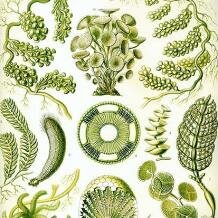Topic: Agriculture in marine polychaete annelids
Some polychaetes attach pieces of algae to their dwelling tube. Just for decoration? No, but for a much more substantial (and convergent) benefit...
 Polychaete annelids show a wide variety of feeding habits, ranging from the filter feeding of the tube worms (with their convergent evolution of compound eyes) to the predatory activity of such groups as the alciopids (that have independently evolved camera eyes). Some species are grazers, and this has opened the door to agriculture, a behaviour much better known from other groups of animals, particularly insects such as attine ants and termites.
Polychaete annelids show a wide variety of feeding habits, ranging from the filter feeding of the tube worms (with their convergent evolution of compound eyes) to the predatory activity of such groups as the alciopids (that have independently evolved camera eyes). Some species are grazers, and this has opened the door to agriculture, a behaviour much better known from other groups of animals, particularly insects such as attine ants and termites.
Marine polychaetes that are “farmers”? Welcome to the families Nereidae (e.g. Nereis vexillosa and Platynereis bicanaliculata) and Onuphidae. In these groups, the worms not only decorate their dwelling tubes with pieces of drifting algae (e.g. chlorophytes), but this has been interpreted as a variety of gardening. This is because the worms have been observed to nibble these algae regularly, and it seems likely that the permanent algal cover serves as food and so increases the predictability of the worms’ food supply.
But this is not the only advantage of this association. It has been suggested that the algae also change the level of physical stress in the worm’s environment. They modulate temperature and, as they retain water locally when the intertidal mud flats fall dry, their presence furthermore reduces salinity stress as well as the risk of desiccation. However, there might be a disadvantage, at least for those worms that are oriented head downward in a vertical tube. Here, the algal cover at the tube entrance could impair the worm’s access to the layers of oxygenated water above the surface of the sediment.
The alga probably benefits by obtaining a secure attachment site, particularly in areas where hard substrata suitable for anchorage are scarce. In addition, the alga’s ability to colonise new habitats might be improved spatially as well as temporally. The worms’ ‘gardening’ behaviour thus increases the complexity of the environment and has the potential to change the structure of the habitat.
Some other polychaetes are known to graze filamentous algae, similar to the behaviour of damselfish, but it is not known if this ranks as cultivation. The herbivorous nereid Platynereis dumerilii selectively feeds on erect micro- and macroalgae, which can quite easily be cut by its jaws. Longer worms were also shown to graze on leaves of the Mediterranean seagrass Posidonia oceanica when starved, a behaviour otherwise rarely reported for invertebrates in marine ecosystems.
Cite this web page
Map of Life - "Agriculture in marine polychaete annelids"
https://mapoflife.org/topics/topic_474_agriculture-in-marine-polychaete-annelids/
November 29, 2020

